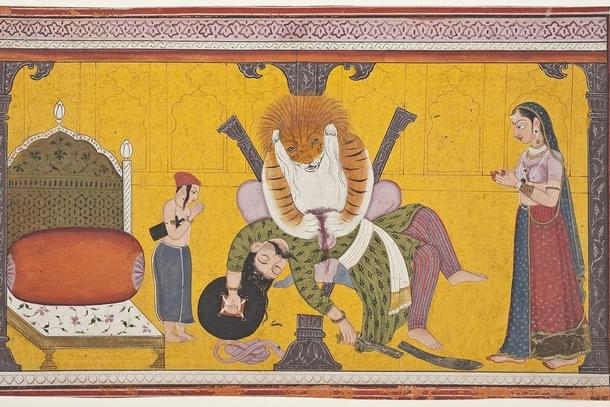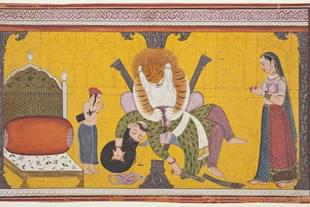Culture
Hola Mohalla Plus Much More: Holi In The Sikh Tradition
Rohit Pathania
Mar 07, 2023, 08:28 PM | Updated 09:04 PM IST
Save & read from anywhere!
Bookmark stories for easy access on any device or the Swarajya app.


Holi has been a festival of much pomp and colour for all Indic traditions, and the Sikh panth is no exception.
Hola Mohalla at Anandpur Sahib is definitely a big event and a spectacle.
The festival of Hola Mohalla was initiated by Guru Gobind Singh ji, the tenth Guru of the Sikhs around 1688 in Anandpur Sahib.
As per the stories about the event, Guru Gobind Singh ji initiated two groups to undertake a mock battle with each other, with the intention of instilling martial spirit among the Sikhs.
Post the win of one group over the other, Guru Gobind Singh ji distributed kadha prashad among the people.
Today, Nihang groups perform stunts and display their martial arts skills to the thousands of devotees who throng the place every year at the time of the festival.
The festival attracts even tourists from around the world, thanks to its pomp and splendour and the sense of sangat that one feels in the three-day event.
The festival has also gained the interest of film makers in recent times, with Punjabi language movies like Sikander and the controversial 2006 movie Rang De Basanti shooting the climax or important parts of the movie in the backdrop of the festival.
The tradition of Holi, however, is far deeper than that when it comes to the Sikh tradition.
The gurus, it is believed, used to play with gulaal and colours on the festival.
Holi of course is not just about the colours — it is also a festival of deep contemplation of bhakti bhaav.
Much like many great poets of yore who saw in Holi the parama praakatya of Sri Krishna’s lila and the gratitude of his devotees, the deep sense of bhakti and joie de vivre espoused in the Faag Mahotsav of Holi can perhaps also be sensed in the Gurbani. In the words of the Fifth Guru, Sri Guru Arjan Dev, as recorded in the Sri Guru Granth Sahib Ji:
बसंतु महला ५ घरु १ दुतुके
ੴ सतिगुर प्रसादि ॥
गुरु सेवउ करि नमसकार ॥
आजु हमारै मंगलचार ॥
आजु हमारै महा अनंद ॥
चिंत लथी भेटे गोबिंद ॥१॥
आजु हमारै ग्रिहि बसंत ॥
गुन गाए प्रभ तुम्ह बेअंत ॥१॥ रहाउ ॥
आजु हमारै बने फाग ॥
प्रभ संगी मिलि खेलन लाग ॥
होली कीनी संत सेव ॥
रंगु लागा अति लाल देव ॥२॥
मनु तनु मउलिओ अति अनूप ॥
सूकै नाही छाव धूप ॥
सगली रूती हरिआ होइ ॥
सद बसंत गुर मिले देव ॥३॥
बिरखु जमिओ है पारजात ॥
फूल लगे फल रतन भांति ॥
त्रिपति अघाने हरि गुणह गाइ ॥
जन नानक हरि हरि हरि धिआइ ॥४॥१॥
Basant, Fifth Mehl, First House, Du-Tukay:
One Universal Creator God. By The Grace Of The True Guru:
I serve the Guru, and humbly bow to Him.
Today is a day of celebration for me.
Today I am in supreme bliss.
My anxiety is dispelled, and I have met the Lord of the Universe. ||1||
Today, it is springtime in my household.
I sing Your Glorious Praises, O Infinite Lord God. ||1||Pause||
Today, I am celebrating the festival of Phalgun.
Joining with God's companions, I have begun to play.
I celebrate the festival of Holi by serving the Saints.
I am imbued with the deep crimson colour of the Lord's Divine Love. ||2||
My mind and body have blossomed forth, in utter, incomparable beauty.
They do not dry out in either sunshine or shade;
they flourish in all seasons.
It is always springtime, when I meet with the Divine Guru. ||3||
The wish-fulfilling Elysian Tree has sprouted and grown.
It bears flowers and fruits, jewels of all sorts.
I am satisfied and fulfilled, singing the Glorious Praises of the Lord.
Servant Nanak meditates on the Lord, Har, Har, Har. ||4||1||
Of course, Holi’s colours are not just restricted to the holy words of the earlier gurus.
Another interesting aspect of the reference to Holi can be seen in the Dasam Granth of Sri Guru Gobind Singh ji.
As part of the Krishan Avatar story, Sri Guru Gobind Singh ji has written the following on Sri Krishna playing Holi with the gopis, where he also slays the demon Pralamb:
अथ गोपिन सो होली खेलबो ॥
सवैया ॥
माघ बितीत भए रुति फागुन; आइ गई सभ खेलत होरी ॥
गावत गीत बजावत ताल; कहै मुख ते भरूआ मिलि होरी ॥
डारत है अलिता बनिता; छटिका संगि मारत बैसन थोरी ॥
खेलत स्याम धमार अनूप; महा मिलि सुंदरि सावल गोरी ॥२२५॥
अंत बसंत भए रुति ग्रीखम; आइ गई हर खेल मचाइओ ॥
आवहु मिक दुहूं दिस ते तुम; कान्ह भए धनठी सुख पायो ॥
दैत प्रल्मब बडो कपटी तब; बालक रूप धरियो न जनायो ॥
कंध चड़ाइ हली को उडिओ; तिनि मूकन सो धरि मारि गिरायो ॥२२६॥
केसव राम भए धनठी मिक; बाल कए तब ही सभ पिआरे ॥
दैत मिकियो सुत नंदहि के संगि; खेलि जित्यो मुसली, हरि हारे ॥
आव चड़ो न चड़िओ सु कहियो; इन पै तिह के बपु को पग धारे ॥
मारि गिराइ दयो धरनी पर; बीर बडो उन मूकन मारे ॥२२७॥
इति स्री बचित्र नाटके क्रिसनावतारे प्रल्मब दैत बधहि ॥
After the month of Magh, in the season of Phagun, all began to play Holi
All the people gathered together in couples and sang songs with the playing of musical instruments
Various colours were splashed on women and the women beat the men with staffs (with affection)
The poet Shyam says that Krishna and beautiful damsels are together playing this tumultuous Holi.225.
When the spring season ended, and with the beginning of the summer, Krishna began to play Holi with pomp and show
The people poured in from both sides and were pleased to see Krishna as their leader
In all this tumult, a demon named Pralamb assuming the appearance of a youth came and mixed with other youths
He carried Krishna on his shoulder and flew, Krishna caused the fall of that demon with his fists.226.
Krishna became the leader and began to play with lovely boys
The demon also became the playmate of Krishna and in that play Balram won and Krishna was defeated
Then Krishna asked Haldhar to mount on the body of that demon
Balram put his foot on his body and causing his fall, he threw him (on the ground) and with his fists killed him.227.
End of the killing of the demon Palamb in Krishnavatar in Bachittar Natak.
Of course, the story of Holi can never be complete without reference to Prahlad and Hiranyakashyapu.
Prahlad is seen as among the param bhaktas, and is an example in the Sikh tradition.
As Bhai Gurdas in his Vaar 10 mentions the story of Bhagat Prahlad:
घरि हरणाखस दैत दे कलरि कवलु भगतु प्रहिलादु ।
पढ़न पठाइआ चाटसाल पांधे चिति होआ अहिलादु ।
सिमरै मन विचि राम नाम गावै सबदु अनाहदु नादु ।
भगति करनि सभ चाटड़ै पांधे होइ रहे विसमादु ।
राजे पासि रूआइआ दोखी दैति वधाइआ वादु ।
जल अगनी विचि घतिआ जलै न डुबै गुर परसादि ।
कढि खड़गु सदि पुछिआ कउणु सु तेरा है उसतादु ।
थंम्हु पाड़ि परगटिआ नरसिंघ रूप अनूप अनादि ।
बेमुख पकड़ि पछाड़िअनु संत सहाई आदि जुगादि ।
जै जैकार करनि ब्रहमादि ।२।
Prahlad, the saint, was born in the house of demon (king) Haranakhas like a lotus is born in the alkaline (barren) land.
When he was sent to seminary, the Brahmin purohit became elated (because the king’s son was now his disciple).
Prahlad would remember the name of Ram in his heart and outwardly also he would eulogise the lord.
Now all the disciples became devotees of Lord, which was an awful and embarrassing situation for all the teachers.
The priest (teacher) reported or complained to the king (that O king your son has become devotee of god).
The malevolent demon picked up the quarrel. Prahlad was thrown into fire and water but with the grace of guru (the lord) neither he was burnt nor drowned.
Angered as he was, Hiranyaksyapu took out his double-edged sword and asked Prahlad who his guru (lord) was.
At the same moment lord god in the form of man-lion came out of pillar. His form was grand and majestic.
That wicked demon was thrown down and killed and thus it was proved that the lord is kind to devotees since the time immemorial.
Seeing this, Brahma and other gods started eulogising the lord.
The syncretism of Indic traditions reflects through the writings of the gurus and the great followers of the gurus like Bhai Gurdas.
This thread that continues to link the traditions of this great land and its long running jnana parampara.
While Saraswati may have dried out in the land of Madra desha, the Saraswati of jnana and bhakti continues to flow unabated in these lands.
Rohit Pathania works in the space of renewable energy and environment. Other interests include politics and the economy.




